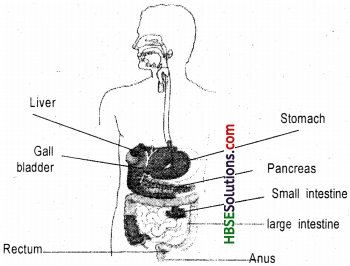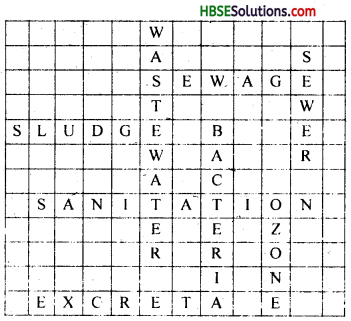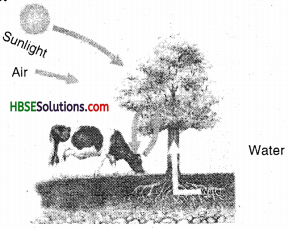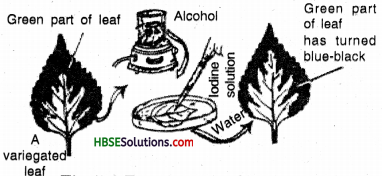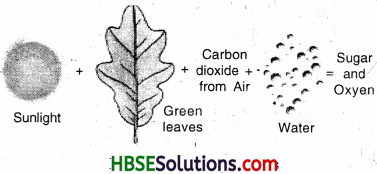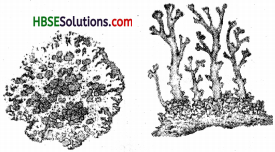HBSE 7th Class Science Solutions Chapter 3 Fibre to Fabric
Haryana State Board HBSE 7th Class Science Solutions Chapter 3 Fibre to Fabric Textbook Exercise Questions and Answers.
Haryana Board 7th Class Science Solutions Chapter 3 Fibre to Fabric
HBSE 7th Class Science Fibre to Fabric Textbook Questions and Answers
Question 1.
You must be familiar with the following nursery rhymes:
(i) Baa baa black sheep, have you any wool
(ii) Mary had a little lamb, whose fleece was white as snow
Answer the following:
(a) Which parts of the black sheep have wool?
(b) What is meant by the white fleece of the lamb?
Answer:
(a) The Hair (fleece) of the black sheep have wool.
(b) The white fleece is the v/hite hair of the lamb.
Question 2.
The silkworm is (a) a caterpiller, (b) a Larva. Choose the correct option.
(i) a
(ii) b
(iii) both a and b
(iv) neither a nor b.
Answer:
(iii) both a and b.
Question 3.
Which of the following does not yield wool?
(i) Yak
(ii) Camel
(iii) Goat
(iv) Woolly dog.
Answer:
(iv) Woolly Dog.
Question 4.
What is meant by the following terms?
(i) Reasing
(ii) Shearing
(iii) Sericulture
Answer:
(i) The fleece of the sheep alongwith a thin layer of skin is removed from its body. This process is called shearing.
(ii) Silk fibres are also animal fibres. Silkworms spin the ‘silk fibres’.
(iii) The rearing of silkworms for obtaining silk is called sericulture.
![]()
Question 5.
Given below is a sequence of steps in the processing of wool. Which are the missing steps? Add them.
Shearing, ………………. , sorting, ………………. , ………………. , ………………. , ………………. .
Answer:
Shearing, scouring, sorting, drying, dying, spinning, weaving.
Question 6.
Make sketches of the two stages in the life history of the silk moth which are directly related to the production of silk.
Answer:
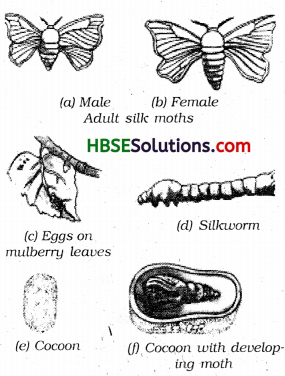
(a) Female silkworm moth with eggs
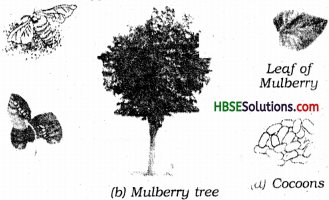
Question 7.
Out of the following, which are the two terms related to silk production? Sericulture, Floriculture, Moriculture, Apiculture, Silviculture
Hints:
(i) Silk production involves cultivation of mulberry leaves and rearing silkworms.
(ii) Scientific name of mulberry is Morus alba.
Answer:
Sericulture, Moriculture.
Question 8.
Match the words of column I with those given in column II.
| Column I | Column II |
| 1. Scouring | (a) Yields silk fibres |
| 2. Mulberry leaves | (b) Wool yielding animal |
| 3. Yak | (c) Food of silk worm |
| 4. Cocoon | (d) Reeling |
| (e) Cleaning sheared skin |
Answer:
| Column I | Column II |
| 1. Scouring | (e) Cleaning sheared skin |
| 2. Mulberry leaves | (c) Food of silk worm |
| 3. Yak | (b) Wool yielding animal |
| 4. Cocoon | (a) Yields silk fibres |
Question 9.
Given below is a crossword puzzle based on this lesson. Use hints to fill in the blank spaces with letters that complete the words.

Answer:
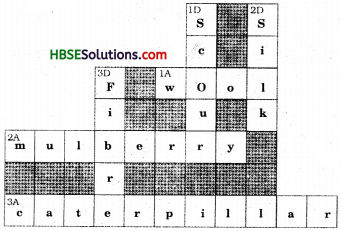
Extended Learning-Activities And Projects
Question 1.
Paheli wants to know the maximum length of continuous silk thread that can be obtained from a cocoon.
Answer:
Do yourself. Take help to your teacher.
Question 2.
Boojho wants to know why caterpillars need to shed their skin when they grow bigger but we humans do not.
Answer:
Do yourself.
Question 3.
Boojho wants to know why caterpillars should not be collected with bare hands.
Answer:
Do yourself.
![]()
Question 4.
Paheli wanted to buy a silk frock and went to the market with her mother. There they found that the artificial (synthetic) silk was much cheaper and wanted to know why Do you know why? Find out.
Answer:
Do yourself.
Question 5.
Someone told Paheli that an animal called ‘Vicuna’ also gives wooljl Can you tell her where this animal is found? Look for this in a dictionary or an encyclopaedia.
Answer:
Do yourself.
Question 6.
When handloom and textile exhibitions are held, certain stalls display real moths of various varieties of silk and their life histories. Try and visit these stalls with elders or teachers and see these moths and stages of their life history.
Answer:
Do yourself.
Question 7.
Look for eggs of any moth or butterfly in your garden or park or any other place full of plants. They look like tiny specks (dots) laid in a cluster on the leaves. Pull out the leaves containing eggs and-place them in a cardboard box. Take some leaves of the same plant or another plant of the same variety, chop them and put them in the box. Eggs will hatch into caterpillars, which are busy eating day and night. Add leaves everyday for them to feed upon. Sometimes you may be able to collect the caterpillars. But be careful. Use a paper napkin or a paper to hold a caterpillar.
Observe everyday. Note the
(i) number of days taken for eggs to hatch
(ii) number of days taken to reach the cocoon stage and
(iii) to complete life cycle. Record your observations in your notebook.
Answer:
Do yourself.
HBSE 7th Class Science Fibre to Fabric Important Questions and Answers
Very Short Answer Type Questions
Question 1.
Name the sources of obtaining fibres.
Answer:
The sources of obtaining fibres are plants and animals.
Question 2.
Name some wool yielding animals.
Answer:
Some wool yielding animals are: sheep, angora goat, goat, yak, camel, llama, alpaca.
Question 3.
What is shearing?
Answer:
The fleece (hair) of the sheep alongwith a thin layer of skin is removed from its body. This process is called shearing.
![]()
Question 4.
From where do we get wool and silk fibres?
Answer:
Wool and silk fibres are obtained from animals. Wool is obtained from hair of animals ; as sheep hairs and silk fibtes are obtained from silk worm.
Question 5.
What is wool?
Answer:
Wool is the common name of applied to soft curly fibres obtained chiefly from the fleece of domesticated sheep.
Question 6.
What determines the fineness of wool?
Answer:
The number of crimps per centimetre determines the fineness of wool fibre.
Question 7.
Name two breeds of sheep which has finest fleece?
Answer:
Two breeds of sheep which has finest fleece are: merino and Karakul.
Question 8.
Name two systems used in the processing of wool.
Answer:
Two system used in the processing of wool are:
1. Woollen system
2. Worsted system.
Question 9.
Name two substance removed from row wool, before manufacturing yam.
Answer:
Two substance removed from raw wool, before manufacturing yarn are:
1. Yolk
2. Suint.
Question 10.
What is woolmark?
Answer:
Woolmark is the mark of standardisation given to woollen yarns and woollen products. This mark has been instituted by International Wool Secretariat (I.W.S.) located in North Yorkshire (U.K.).
Question 11.
What are the uses of wool?
Answer:
Wool is used for making fabrics, shawls, blankets, carpets, felt and upholstery.
Question 12.
Write the properties of wool fibre.
Answer:
Wool fibre is considerably resilient, has high tensile strength, light weight and is heat insulator.
Question 13.
Name the domesticated moth whose larva produces silk.
Answer:
Silk is obtained from the cocoon of the pupa of mulberry silk moth.
Question 14.
Name the plant on which silk larva feeds.
Answer:
Silk larva feeds on the leaves of mulberry tree.
Question 15.
Name the person responsible for the discovery of silk.
Answer:
Silk was discovered by Xi-Ling-Shi, the bride of Chinese emperor Huang Di, in about 3000 B.C.
Question 16.
Name the strongest variety of silk.State whether the variety you have named is wild silk or domesticated silk.
Answer:
The strongest variety of silk is “Muga”. It is the variety of wild silk.
![]()
Question 17.
Name the different varieties of processed silk.
Answer:
Organize, Gepe, Tram and Thrown Singles are different, varieties of processed silk.
Question 18.
Give uses of silk, other than for making dresses.
Answer:
Other than for making dresses, silk is used for items such as parachutes, bicycle tyres, bullet proof vests and non-absorbable sutures in surgery.
Question 19.
What is sericulture?
Answer:
The science of raising silkworms, so as to obtain silk cocoons, is called sericulture.
Question 20.
Where are sheep reared in India?
Answer:
In India sheep are reared in Sub-Himalyan region which has a cooler climate.
Question 21.
Differentiate between staple fibres and filament fibres.
Answer:
The fibres like cotton, jute, and wool are short in length. Silk however, is the longest natural fibre. The short fibres are known as the stable fibres, where as long fibres are known as the filament fibres.
Question 22.
Name some Indian breeds of sheep.
Answer:
Some Indian breeds of sheep are Lohi, Rampur bushair, Nali, Bakharwal, Marwari, and Patanwadi.
Question 23.
What is reeling of silk?
Answer:
A pile of cocoons is used for obtaining silk fibres. This process is called reeling of silk.
Short Answer Type Questions
Question 1.
Differentiate between woollen yarn and worsted yam.
Answer:
The woolen yarn is made from the woolen fibres of mixed lenghts. These fibres are, carded and spun to form a woolen yarn. The articles made from this yarn do not have smooth finished surface.
In the worsted yarn, only the long fibres are used. They are formed into smooth compact strands and are then spun to form woolen yarn. The articles made from these have smooth finished surface.
![]()
Question 2.
What do you mean by the term ‘weighting of sillf’?
Answer:
Silk when unwound from the cocoon is covered with a sticky substance. This has to be removed by washing process. As a result, silk loses about 20% of its weight. To make up for this loss some manufactures dip silk in metallic salt solution. This is known as weighting of the silk. This silk is weaker than pure silk. It than not be cleaned properly. This silk is of substandard quality and hence, deceives the buyers.
Question 3.
What is raw silk? How is it produced?
Answer:
After brushing, filaments from four to eight cocoons are joined and twisted. They are then combined with a number of other similarly twisted filaments, to make a thread that is wound on a reel. The thread is called raw silk.
It usually consists of 48 individual silk fibres. When each cocoon is unwound, it is replaced by another cocoon.Unlike the threads spun from other natural fibres, such as cotton or wool, the silk thread is made of extremely long fibres.
Question 4.
Name and describe any two types of silk threads used in the making of silk cloth.
Answer:
Two types of silk threads used in the making of silk cloth are:
1. Organzine:
Organzine thread is made by giving raw silk thread a preliminary twist in one direction and then twisting two or more of these threads in the opposite direction at rate of about 4 turns / cm.
2. Crepe: Crepe is similar to organzine, but it twisted to much greater extent, usually, 16 to 32 turns / cm.
Question 5.
Why do the wool fibres have greater bulk as compared to other fibres?
Answer:
The scales and crimps in the wool fibre make it possible to spin and felt the fleece. They help the individual wool fibres “grab” each other so that they stay together. Because of the crimp, wool fabrics have a greater bulk; than other textiles. They can retain lot of air and hence wool fabrics are good insulators of heat. The heat insulation also works boths ways.
Question 6.
Name the some breeds of sheep reared in our country. Also, indicate the quality and texture of the fibres obtained from them.
Answer:
Some Indian breeds of sheep:
Answer:
| Name of breed | Quality of wool | State where found |
| 1. Lohi | Good quality wool | Rajasthan, Punjab |
| 2. Rampur bushair | Brown fleece | Uttar Pradesh, Himachal |
| 3. Nali | Carpet wool | Rajasthan, Haryana, Punjab |
| 4. Bakharwal | For woollen shawls | Jammu and Kashmir |
| 5. Marwari | Coarse wool | Gujarat |
| 6. Patanwadi | For hosiery | Gujarat |
Question 7.
Write short note on ‘wool production’.
Answer:
Australia is the world’s largest producer of raw wool and contributes 29% of total world supply. Other leading producers of wool are former Soviet Republics, New Zealand, China, Argentina, South Africa and Uruguay. In India sheep are reared in Sub-Himalayan regions which has a cooler climate. The sheep which are reared in Rajasthan have poor quality of wool and are mainly reared for meat.
Long Answer Type Questions
Question 1.
What is raw silk? How is it produced?
Answer:
After brushing, filaments from four to eight cocoons are joined and twisted. They are then combined with a number of other similarly twisted filaments, to make a thread that is wound oft a reel. The thread is called raw silk. It usually consists of 48 individual silk fibres. When each cocoon is unwound, it is replaced by another cocoon. Unlike the threads spun from other natural fibres, such as cotton or wool, the silk thread is made of extremely long fibres. About 5,500 cocoons are required to produced 1 kg of raw silk.
![]()
Question 2.
What is sericulture? Explain in brief.
Answer:
The silk is obtained from cocoon. When the complete cocoon is formed, they are collected. The pupa inside the cocoon is killed by treating the cocoons with boiling water. This hot water not only kills the cocoons but also dissolves the sticky substance that holds the cocoon filaments in place. The cocoons are, thereafter, dried and brushed. This removes the outer portion that is made of coarse filaments.
The thread is then unwound from the cocoons and is wound on a reel. The thread is called the raw silk. It generally consists of 48 individual silk fibres. The silk filaments are unwound from cocoon in a manufacturing plant known as filature. The silk thread is made up of extremely long fibres. About 5,500 silkworms are needed to produce 1 kg of raw silk. The breeding and management of silk moths for producing silk is known as sericulture.
Question 3.
Explain briefly the process of wool manufacturing.
Answer:
In order to make different articles, the raw wool is processed which starts with sorting of the fibres. The fibres are sorted on the basis of length, fineness, etc. The sorting is followed by cleaning 6f the fibres. Using a suitable detergent, the fibres are cleaned from lanolin (an oily substance) and suint (the dried perspiration of sheep). The cleaned wool fibres are then dried and disentangled. Thereafter, they are drawn into a straight continuous thread. This process is called cerding. The kind of yarns that are produced may be woollen yarn or worsted yarn.
For the production oi wooiien yarn, the web is split into fine thin strands, by a process called roving. It is then spun into woollen yarn. Woollen fabric such as tweed is woven from woollen yarn. It is a bulky fabric in which short woollen fibres are arranged randomly. It does not have smooth surface.
For the production of worsted yam, the web is processed by the machines that (i) straighten the fibres (ii) make them parallel (iii) remove all the short fibres. The resultant woolen strand is then condensed by passing it through several machines, until a very thin strand of worsted roving is obtained. It is then spun to a smooth yarn.
Question 4.
What are the uses of wool? What is woolmark?
Answer:
Wool is used for making fabrics, shawls, blankets, carpets, felt (compressed wool) and upholstery. Wool felt is used to cover piano hammers. It is also used to absorb noise in heavy machinery and stereo speakers.
Shoddy is made from the used wool. To make shoddy, the existing wool fabric is cut into small pieces and then carddd. The carded wool is then respun into yarn. Such a yarn is inferior to the fresh wool and is used for making cheap woollen garments and blankets.
Woolmark:
Wool is marketed worldwide by the International Wool Secretariat (IWS), which is based in Ilkley, North Yorkshise (U.K.). The “Woolmark” instituted by IWS indicates that garments bearing this sign are made from pure new wool, that has not been used previously in any process.
![]()
Fibre to Fabric Class 7 HBSE Notes
- Wool comes from sheep, goat, yak and some other animals. These wool- yielding animals bear hair (fleece) on their body.
- The hairy skin of the sheep has two types of fibres that form its fleece : (i) the coarse beard hair, and (ii) the fine soft under hair close to the skin.
- The wool which is used for knitting sweaters or for weaving shawls is the finished product of a long process.
- Sheep hair is sheared off from the body, scoured, sorted, dried, dyed, spun and woven to yield wool.
- The hairs of camel, llama and alpaca are also processed to yield wool.
- The wool may be classified as Virgin, Hogg or pulled depending upon its quality.
- In wool production, Australia and New Zealand produce two-thirds of the world’s supply.
- Woolmark is the mark of standardisation given to pure and new wool.
- Silk fibres are also animal fibres. Silkworms spin the ‘silk fibres’. The rearing of silkworms for obtaining silk is called sericulture.
- The female silk moth lays eggs, from which hatch larvae which are called caterpillars or silkworms.
- During their life cycle, the worms spin cocoons of silk fibres.
- Silk fibres are made of a protein.
- Tassar silk, mooga silk, kosa silk, etc., are obtained from cocoons spun by different types of moths.
- The most common silk moth is the mulberry silk moth. The silk fibre from the cocoon of this moth is soft, lustrous and elastic and can be dyed in beautiful colours.
- Sericulture is a very old occupation in India. India produces plenty of silk on a commercial scale.
- A pile of cocoons is used for obtaining silk fibres. This process is called reeling of silk. The cocoons are kept under the sun or boiled or exposed to steam. The silk fibres separate out. The process of taking out threads from the cocoon for use as silk is called reeling the silk.

